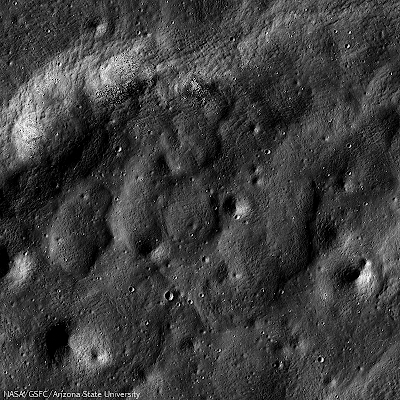Straddling both the Moon's near and far sides (on the young Crescent Moon, visible at a high line-of-sight angle through modest binoculars about two days after a New Moon) is Pre-Nectarian (approximately 4.55 billion years old), 515 kilometer-wide Mare Australe. Aeons older than the more familiar basins clustered on the Moon's nearside, this is one of the Moon's features that quietly archives the earliest formative history of the Solar System (and Earth).
Drew Enns and Arizona State University's Lunar Reconnaissance Orbiter Camera (LROC) team, focus this week on two far younger features of this very ancient impact. Above is take from the LROC Web Map Server Image Map, now layered with LROC Wide Angle Camera mosaic images and centered near 60 degrees south and 70 degrees east of the Moon's central meridian. At lower right is the more "recent" "borderline basin" Schrödinger, carved into the east southern polar regions but outside the vast interior of South Pole-Aitken (SPA) basin [NASA/GSFC/Arizona State University].
Drew Enns and Arizona State University's Lunar Reconnaissance Orbiter Camera (LROC) team, focus this week on two far younger features of this very ancient impact. Above is take from the LROC Web Map Server Image Map, now layered with LROC Wide Angle Camera mosaic images and centered near 60 degrees south and 70 degrees east of the Moon's central meridian. At lower right is the more "recent" "borderline basin" Schrödinger, carved into the east southern polar regions but outside the vast interior of South Pole-Aitken (SPA) basin [NASA/GSFC/Arizona State University].
A beautiful wrinkle ridge within Brisbane Z crater in Mare Australe. Image width is 500 m and illumination is from the left; LROC Narrow Angle Camera observation M134714924L, LRO orbit 4986, July 25, 2010. See the full-sized LROC Featured Image HERE [NASA/GSFC/Arizona State University].
Drew Enns
LROC News System
This wrinkle ridge is located within the crater Brisbane Z (52.72°S, 73.13°E), a mare-flooded crater within Mare Australe. Wrinkle ridges are one of several styles of tectonic deformation present on the Moon, and occur primarily in the maria. Wrinkle ridges are the result of contractional forces, and in the maria, these forces are believed to be from the weight of the basalts extruded onto the surface. The same reasoning explains why wrinkle ridges are sometimes found in mare-flooded craters, where similar contractional forces are present at a smaller scale.
LROC Wide Angle Camera (WAC) monochrome context of Brisbane Z. View the full-sized WAC context image, HERE. LROC's Featured Image is framed by the marked box; image field of view is 100 kilometers [NASA/GSFC/Arizona State University].
The dramatic wrinkles and folds of this ridge give a sense of the strong forces that shaped this area, disrupting the once-smooth mare surface. In the context image above you can see that this is just the tail of a wrinkle ridge that spans tens of kilometers, crossing over half of Brisbane Z's floor.
Check out more of the wrinkle ridge in the full NAC image!
Related Posts:
Wrinkle ridge in Oceanus Procellarum
Wrinkle ridges of northwest Mare Imbrium
Bright ridge near Mons Hansteen




No comments:
Post a Comment